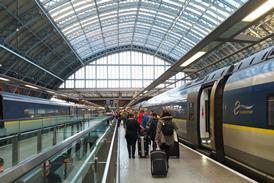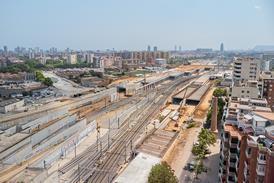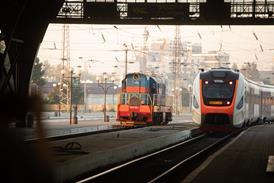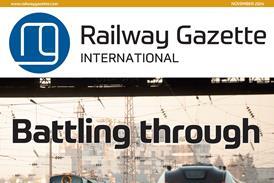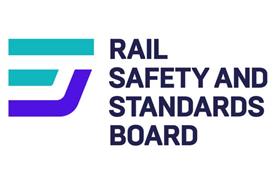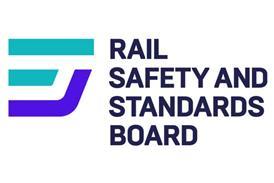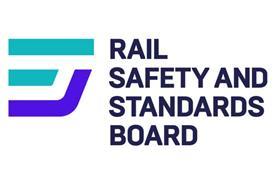INTRO: Construction began earlier this year on the 15·5 km South Corridor route in Charlotte, the first light rail project in this rapidly-growing city in North Carolina. William D Middleton reports
LIGHT RAIL has a key role to play in Charlotte, North Carolina, where an initial line is now under construction. Between 1990 and 2000, the city’s population grew by almost 37%, and planners expect this increase to continue, with employment forecast to grow by almost 50% by 2025.
With sprawling urban development, car use on an increasingly congested road network has risen at an even faster rate. Planners and local politicians in Charlotte and the surrounding Mecklenburg County were convinced there had to be a better way to grow.
The result was a remarkably comprehensive 2025 Integrated Transit/Land Use Plan developed by the Metropolitan Transportation Commission. This foresees the creation of a public transport network including commuter rail, light rail, heritage trams and buses operating in five corridors, closely co-ordinated with land-use policy to foster use of public transport rather than the private car.
The plan and an associated 0·005% (half-cent) sales tax to fund transport development were approved by voters in November 1998 with a 58% majority in favour. A major investment study for the South Corridor began soon afterwards, with light rail selected early in 2000. At the same time, bus operator Charlotte Area Transit System began studies for the other four corridors to define the preferred alignments and systems in more detail. These studies were completed in 2002, and by 2025 CATS expects to be carrying four times the present level of ridership on an expanded network including 45 km of bus rapid transit (operating on dedicated busways with off-vehicle ticketing), 33·8 km of light rail, 17·7 km of heritage trams and 48·3 km of commuter heavy rail.
At the same time, planning policy across the greater Charlotte area has been modified to encourage higher-density, mixed-use development along the corridors, which changes to lower density housing adjacent to existing single-family residences. Mecklenburg and four cities have already adopted Transit Station Area Joint Development Principles. The transit-oriented policy adopted by the City of Charlotte, for example, seeks to encourage high-density residential, commercial or mixed-use development within an 800m radius of stations that will boost public transport use. Other types of development may also be permitted.
Given the initial major investment in studies for all five of the corridors, CATS Chief Executive Officer Ron Tober has stressed the importance of making an early start on the development of transit-oriented planning policies. ’We shouldn’t be spending all this money on the transit system’, he said, ’if we’re not going to do the land-use planning’.
South Corridor route
The South Corridor light rail route will extend from 7th Street South in downtown Charlotte to a terminus at I-485/South Boulevard, just inside the circumferential I-485 expressway corridor. The Charlotte Transportation Center/Arena station in the city centre city will provide interchange with buses, as well as future rapid transit routes.
For almost its entire length, the light rail line will closely parallel the adjacent South Boulevard, following a railway line owned by Norfolk Southern. NS will continue to operate freight trains as far north as Woodlawn Avenue, but on separate tracks east of the light rail route. The entire line will be double-tracked, operating on a surface alignment, with bridges over the busy road junctions at Woodlawn and Tyvola roads, Archdale Drive and Arrowood Road. Park-and-ride facilities at seven stations at the southern end of the route will offer a total of 3600 spaces.
Extensive road changes will be required adjacent to Scaleybark Road, where several blocks of the adjacent South Boulevard will be rebuilt to provide separate north and southbound lanes on opposite sides of the line. Imaginative use of existing topography will benefit both the light rail station and the adjacent Sterling Elementary School at the I-485/South Boulevard station. A new underpass beneath the railway embankment will provide access to a 1200 space car park built in a ravine owned by the school, which will gain a much-needed playground built on the grassed-over roof of the new facility.
A rolling stock maintenance depot and operations centre is being constructed on part of a 6·9ha site on South Tryon Street, just west of the rail line. A new bus facility on the site was completed earlier this year, while the rail buildings will accommodate offices, a control centre and space to service and maintain a fleet of up to 42 light rail vehicles, sufficient for both the present fleet and future extensions into Charlotte’s Northeast Corridor. Plans for joint bus/rail use of the paint shop, fare collection systems and other services have saved more than $1m in light rail construction costs.
CATS awarded a contract for 16 LRVs for the South Corridor route early in 2004. These will be articulated, 70% low-floor vehicles supplied by Siemens Transportation Systems, similar to LRVs now operating in Houston and San Diego. Final assembly will be undertaken by Siemens at its plant in Sacramento, California, with deliveries scheduled to begin in 2006. Each vehicle will be 27·8m long, weigh 44·2 tonnes when empty and will seat 68, with a maximum capacity of 236 passengers. Top speed will be 88 km/h.
Development underway
CATS was able to begin final design work on the South Corridor project after a federal ’record of decision’ for the scheme was issued in May 2003. Formal approval of the project’s federal full funding agreement was signed on May 6 2005, with 47% of the anticipated $426·8m cost to come from federal funds and another 25% from the state of North Carolina. The remaining 28% will come from the sales tax levied in Charlotte-Mecklenburg.
Construction work began on site at the end of February 2005, including site clearance and grading, utility diversion, bridge pier construction and foundations. Working towards a spring 2007 opening, CATS already has some bridge construction contractors working on six-day or double-shift schedules.
CATS plans to operate services to a 15min base headway between 05.00 and 01.00, with trains operating at 71/2min headways during peak periods. It is expected that the route will carry up to 9100 passengers a day during its first year of operation, increasing to 18300 per day by 2025. The CATS bus network will be modified to feed into the new route, with both local and express buses operating over east-west routes timed to connect with light rail services.
Transit-oriented development along the line is already underway. Transit-friendly projects already in hand along Carson Boulevard, Rensselaer Avenue, and East/West Boulevard include apartment blocks and shops, while the 3030 South residential project is already underway further out, adjacent to the planned light rail station at New Bern.
A novel feature of the South Corridor project will be the parallel Charlotte Trolley heritage tram operation. Begun by a volunteer organisation, the trolley received funding of $16·7m in 1998 to create a 3·2 km transit corridor between Uptown Charlotte and the historic South End district along the line of the future light rail corridor. A single track built in the corridor has been rebuilt to LRT standards.
Already in regular operation with one restored former Charlotte streetcar and three replica cars built by Gomaco Transit Co, the trolley operates to a 30min headway. The line carried over 212000 passengers in the first six months of operations after regular service began in October 2004, far exceeding a first-year projection of 100000 passengers. Trolleys will continue to operate on the South End section of the line, running between light rail services, except during peak periods when light rail service goes to a 71/2min headway.
Four more corridors
The remaining four corridors are planned to include commuter rail and enhanced bus services in the North Corridor, while light rail and bus rapid transit has been selected for the Northeast Corridor. Buses will be provided in both the Southeast and West corridors, and enhanced bus service in portions of the West Corridor. City-centre improvements include plans for a streetcar loop and extensions in the Southeast and West corridor alignments. Completion of the full recommended rapid transit system plan by 2025 will cost an estimated $1·99bn including inflation, with an additional $952m needed for the core bus fleet and other capital investment requirements.
Wanting to further advance its plans for the other four corridors, CATS is now proceeding with another round of still more detailed conceptual studies. Approved by the Federal Transit Administration in 2004, these could lead to further changes to the choice of technology, as well as the priority granted to each scheme. The latest round of studies should be completed for Charlotte-Mecklenburg MTC to decide on the next steps forward in 2006.
While neither a firm choice of mode nor priority has yet been determined, the likeliest route to proceed may well be the North Corridor, which is both further advanced in study development and easier to build. The projected rail corridor will extend 48·3 km northward from Charlotte Gateway station in the city centre over an existing NS route to Mooresville, Iredell County, serving 10 stations. Capital and operating costs will be minimised by upgrading the existing route and implementing improvements as demand requires. The proposed West Trade Multi-Modal Station in the centre of Charlotte will be served by Amtrak, Greyhound coaches and CATS bus and streetcar services, as well as commuter rail. This new terminal will be linked by east-west streetcar and bus rapid transit services on Trade Street with the Charlotte Transportation Center where the South and Northeast corridor light rail lines will meet.
CAPTION: TOP: Land use and planning policy encourages development close to the light rail corridor. New apartments have been built alongside Park Avenue where light rail cars will share tracks with the Charlotte Trolley which has been operating since October 2004
LEFT: Construction in progress. A bridge is being built to carry the light rail line over the busy Tyvola Road
RIGHT: New condominiums form part of the transit-oriented development springing up along the light rail route at 3030 South, near the future New Bern station
CAPTION: Artist’s impression of the future Scaleybark station, showing the light rail line crossing South Boulevard
CAPTION: The South Corridor is part of a comprehensive land use and transport plan that also includes commuter rail and enhanced bus services
CAPTION: South Corridor LRVs will terminate at South Boulevard/Interstate 485 where an access road under the railway embankment will lead to a multi-storey car park next to the Sterling Elementary School
Summaries
Light rail arrives in Charlotte
Construction began earlier this year on the 15·5 km South Corridor light rail project in the rapidly-growing city of Charlotte in North Carolina. The line forms part of a comprehensive plan integrating light rail, commuter rail, trams and bus services with land use planning. Housing and commercial developments is taking place alongside the light rail route, which shares tracks over 3·2 km with a heritage tram services. Charlotte Area Transit System has ordered 16 LRVs from Siemens for delivery from 2006
Le métro léger arrive à Charlotte
La construction a commencé plus t

